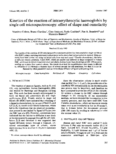论文类型推荐
Entry of animal viruses and macromolecules into cells

Abstract The entry of animal viruses into cells is mediated by conformational changes in certain virion-particle components. These changes are triggered by the binding of virions to receptors and are influenced by low pH during receptor-mediated endocytosis. These conformational alterations promote the interaction of some viral proteins with cellular membranes thereby leading to transient pore formation and the disruption of ionic and pH gradients. The entry of toxins that do not possess receptors on the cell surface is promoted during the translocation of the virus genome or the nucleocapsid to the cytoplasm. A model is now presented which indicates that efficient virus translocation through cellular membranes requires energy, that may be generated by a protonmotive force. The entry of some animal viruses, as promoted by low pH, should thus only take place when a pH gradient and/or a membrane potential exist, but will not take place if these are dissipated, even if virion particles are present in an acidic enviroment.

MiRNA let-7g regulates skeletal myoblast motility via Pinch-2

Abstract Post-transcriptional regulation of gene expression by RNA-binding proteins and by small non-coding RNAs plays an important role in cell biology. Our previous results show that in murine skeletal myoblasts, the expression of Pinch-2, a focal adhesion remodeling factor that regulates cell motility, is repressed by an RNA-binding protein IMP-2/Igf2bp2. We now show that the expression of Pinch-2 is also regulated by the miRNA let-7g. Let-7g and IMP-2 repress Pinch-2 expression independently of each other. A knock-down of let-7g leads to an increase in Pinch-2 expression, and to a decrease of cell motility, which can be reversed by a simultaneous knock-down of Pinch-2. We conclude that let-7g controls the motility of mouse myoblasts in cell culture by post-transcriptionally regulating the expression of Pinch-2.

Clustering in coated vesicles of polyunsaturated phospholipids segregated from plasma and Golgi membranes of adrenocortical cells

Abstract In bovine adrenocortical cells, the fatty acyl chains of the phospholipids have been identified in the membranes of the different cell compartments: plasma membranes, Golgi complex and coated vesicle membranes. An increase in the total number of unsaturation in the fatty acid is demonstrated in the coated vesicle membranes as compared with the plasma and Golgi membranes. Furthermore, it appears that phosphatidylcholine and phosphatidylethanolamine are both enriched in polyunsaturated fatty acyl chains, namely arachidonic and adrenic acids in both types of coated vesicles. Only two of the fatty acids are characteristic of Golgi complex and small coated vesicles, 22:5 (n−6) in PC and 22:6 (n−3) in PE, suggesting that the SCV could originate from the Golgi stacks. A high value of the ratio 22:5 (n−3)/22:6 (n−3) is observed which is, as far as we know, characteristic of adrenal cells.

Expression and stability of recombinant RQ-mRNAs in cell-free translation systems

Abstract Expression of dihydrofolate reductase (DHFR) and chloramphenicol acetyltransferase (CAT) mRNAs in cell-free Escherichia coli translation systems is greatly enhanced as a result of their insertion into RQ135 RNA, a naturally occurring satellite of phage Qβ. The enhancement is due to protection of the recombinant mRNAs against endogenous ribonucleases and to an increased initial rate of translation in the case of the RQ-CAT mRNA.

31P-NMR studies of Mycoplasma gallisepticum cells using a continuous perfusion technique

Abstract 31P-NMR studies of Mycoplasma gallisepticum cells have been carried out using a continuous perfusion technique; these are the first such studies with this organism. Using this technique, glucose metabolism was monitored in the intact organisms, and cell extracts were prepared to identify the intermediates. Under glycolytic conditions, high levels of fructose-1,6-diphosphate were observed, indicating that this sugar may play a key role in the regulation of metabolism. The level of phosphoenolpyruvate was low under normal glycolytic conditions, and did not increase during starvation. From the position of the internal inorganic phosphate peak, the intracellular pH was estimated. The cells were found to maintain an intracellular pH of ~ 7.1 over an investigated external pH range of 6.6–8.6.

Kinetics of the reaction of intraerythrocytic haemoglobin by single cell microspectroscopy: effect of shape and osmolarity

Abstract The kinetics of the reaction of CO with intraerythrocytic haemoglobin has been studied in single red blood cells (RBC) using a scanning microspectrophotometer and a photochemical perturbation method. Measurements have been carried out using red blood cells from man and camel (Camelus dromedarius), the latter at different osmotic pressures. Camel RBC, which are smaller and different in shape compared to human RBC, are known to remain intact even at an osmolarity 6-times lower than physiological (280–290 mosml), swelling up to twice their normal volume. The results show that the recombination time course is affected by diffusion of CO through a stagnant layer of solvent around the cell membrane, but that it is also influenced by other parameters such as intracellular diffusion of ligand and haemoglobin. MicrospectroscopyCamel hemoglobinRed blood cellDiffusionOsmolarityCell volume

Tissue factor pathway inhibitor-2 suppresses the production of active matrix metalloproteinase-2 and is down-regulated in cells harboring activated ras oncogenes

Abstract A human placenta cDNA expression library was screened for genes inducing flat reversion when transfected into a v-K-ras-transformed NIH3T3 cell line, DT. One such gene was found to encode a Kunitz-type serine protease inhibitor, tissue factor pathway inhibitor-2 (TFPI-2). While the TFPI-2 mRNA can be detected in normal human fibroblasts (MRC-5), it is down-regulated in MRC-5 cells expressing an activated H-ras oncogene and in the human fibrosarcoma cell line, HT1080. Restored expression of the TFPI-2 gene in HT1080 cells resulted in the suppression of matrix invasion activity in vitro with concomitant decrease in the relative amount of active matrix metalloproteinase-2 secreted from the cells. When DT cells were cultured in the presence of conditioned medium and extracellular matrix prepared from TFPI-2-transfected HT1080 cells, increased attachment and flat reversion were observed. These results suggest that TFPI-2 may be required for the maintenance of the integrity of extracellular matrix in normal tissues and its down-regulation as a result of oncogene activation may contribute to the malignant phenotypes of tumor cells.

Putative tumor suppression function of SIRT6 in endometrial cancer

Abstract SIRT6, a member of the sirtuin family, has been identified as a candidate tumor suppressor. To pursue the role of SIRT6 in endometrial cancer, we investigated the anti-tumorigenic function of SIRT6. The expression of SIRT6 negatively affected the proliferation of AN3CA and KLE endometrial cancer cells. Increased expression of SIRT6 resulted in the induction of apoptosis by repressing the expression of the anti-apoptotic protein survivin. Consistent with this result, a survivin inhibitor YM155 efficiently inhibited cellular proliferation and induced apoptosis. These results revealed that SIRT6 might function as a tumor suppressor of endometrial cancer cells.

The anti-apoptotic protein BAG-3 is overexpressed in pancreatic cancer and induced by heat stress in pancreatic cancer cell lines

Abstract Pancreatic cancer cells are usually resistant to apoptosis mediated by intrinsic or extrinsic factors. BAG-3 (Bis, CAIR), which was identified as a BAG-1-related protein, is a novel modulator of cellular anti-apoptotic activity that functions through its interaction with Bcl-2. In this study we analyzed BAG-3 expression in human pancreatic cancer tissues and cell lines. BAG-3 mRNA was expressed at moderate to high levels in all pancreatic cancer samples, but at low levels in normal pancreas tissues. In situ hybridization and immunohistochemistry analysis revealed that BAG-3 was present in the cancer cells within the pancreatic tumor mass. When BAG-3 mRNA was analyzed in other gastrointestinal cancers (hepatocellular carcinoma; esophageal, stomach and colon cancer), no difference was found from their corresponding normal controls. In pancreatic cancer cells, BAG-3 mRNA expression levels were strongly induced after heat stress, but not in response to members of the tumor necrosis factor (TNF)-α family (TNF-α, TRAIL, FasL). These findings indicate that in pancreatic cancer, in contrast to other gastrointestinal malignancies, increased levels of BAG-3 might function to block apoptosis. This characteristic of pancreatic cancer might contribute to its more aggressive growth behavior and poor responsiveness to treatment in vivo.

An improved electrofusion technique for production of mouse hybridoma cells

Abstract An experimental procedure is described for the reproducible production of hybridoma cells using the electrofusion technique. High yields can be obtained when fusion is performed in isotonic inositol solutions containing Ca2+ and Mg2+ in a ratio of 1:5 in the millimolar range. The hybridoma cells are transferred 10 min after the field pulse application into a balanced salt solution for 30 min at 37°C.

{{item.title}}
![]()
{{item.summary}}
点击加载更多










